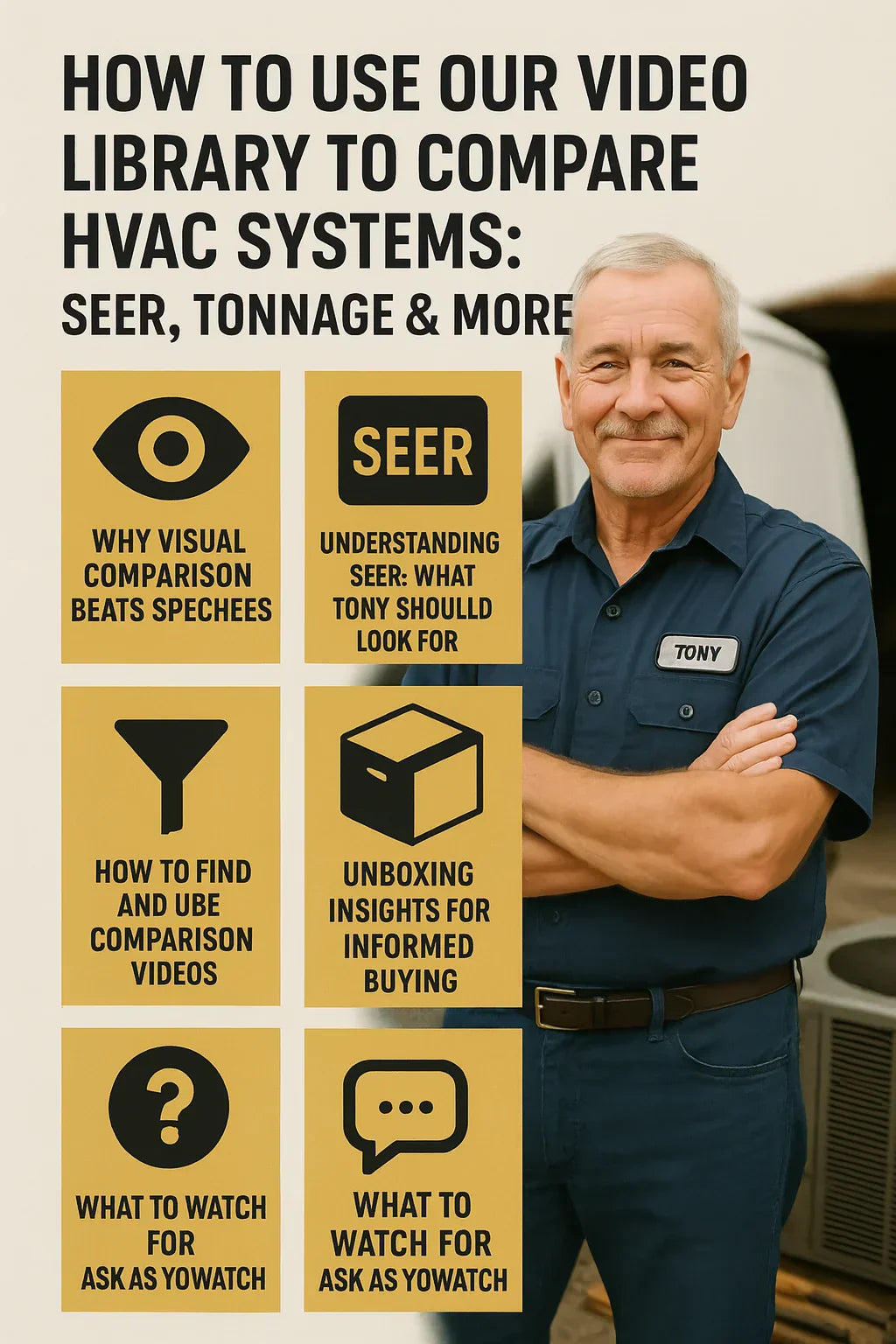1. 🎯 Why Visual Comparison Beats Spec Sheets
1.1 Reading Specs vs. Watching Walkthroughs
Spec sheets list SEER, tonnage, dimensions—but they don’t show you how a unit fits in your attic, how noisy it is, or how duct layout impacts airflow. In videos, Tony sees:
-
Indoor air handler size next to joists
-
Outdoor condenser footprint on a pad
-
Sound/heat insulation nuances
-
Wiring/condensate port positions
Visually comparing units makes benefits instantly real, not theoretical.
1.2 Psychological Impact of Video Learning
Visuals increase:
-
Recall: Watching a 2-minute install can be more memorable than reading 10 pages
-
Confidence: Pause, rewind, review—repeat installation steps until they are second nature
-
Decision speed: Videos help Tony confidently rule out or select systems far faster than reading specs
2. 🧪 Understanding SEER: What Tony Should Look For
2.1 What is SEER?
SEER = Ratio of seasonal cooling output to energy input (BTU per watt-hour) Higher = better efficiency.
-
Minimum in US: SEER 13 for split systems; SEER 14 for package units (per AHRI & DOE)
-
Premium systems: SEER 20–26
2.2 SEER vs SEER2, EER & IEER
The 2023 shift introduced SEER2/EER2, more realistic measures under test pressure Tony should watch for both:
-
SEER/SEER2 for seasonal efficiency
-
EER/EER2 for peak-operation rating
A well-filmed video will show the nameplate, labeling each metric clearly.
2.3 Using Videos to Compare SEER Visually
To assess SEER from video, Tony should:
-
Look at compressor type (inverter/variable‑speed = efficiency)
-
Note coils & fins density—higher SEER units often have denser coils
-
Observe sound insulation or muffling in condenser housing
-
Listen to video audio for evenness of operation
These visual/audio cues help evaluate efficiency in real-world settings.
3. 🧮 Decoding Tonnage: Cooling Capacity in Action
3.1 What “Tons” Means in HVAC
Tonnage equals cooling capacity (1 ton = 12,000 BTU/hour). It’s volume-based, not efficiency-based—unrelated to SEER
3.2 Why Tonnage Matters
-
Undersized = underperformance; oversized = humidity issues
-
Videos show on-site airflow and duct-sizing, offering context beyond the number
3.3 Watch for Spatial Fit
In walkthroughs, Tony sees:
-
Duct connections and clearances
-
Handler orientation (vertical/horizontal)
-
Tailoring to attic vs crawl space
Combine this with spec sheet tonnage to make a full judgement.
4. 🧩 How to Find and Use Comparison Videos
4.1 Filtering & Keywords
-
Look for “vs” or “walkthrough” in titles
-
Filter by “SEER 16 vs SEER 20” or by system type: “central vs mini split”
4.2 How to Compare
-
Pick two comparable walkthroughs
-
Jot timestamps of key points (compressor, coils, wiring)
-
Make notes like:
-
“Video A shows quieter start-up”
-
“Unit B has tighter coil fins, but heavier fan noise”
-
4.3 Use a Comparison Template
Use a checklist like:
| Feature | Video A (SEER 16) | Video B (SEER 20) |
|---|---|---|
| Coil density | Standard | Dense fin-pack |
| Compressor | Single-speed | Variable-speed |
| Installed sound | Medium | Quiet |
| Duct fit | Clearance issues | Proper fit |
Then back it with spec chart—allowing Tony to match what he sees to what specs promise.
5. 📦 Unboxing Insights for Informed Buying
5.1 Know What’s Included
Videos show:
-
Line sets, hardware, filters
-
Unseen extras like brackets, thermostats
-
Any “not included” parts, like wall sleeves or condensate pumps
Tony can avoid delays by ordering extras upfront.
5.2 Compare Units by Packaging
-
Are premium models offering extra hardware?
-
Are budget models missing preventive items like filters?
Visual comparison reveals which capacitors, fuses, or adaptors are included or absent.
6. 🔍 What To Watch For: Ask As You Watch
Tony should pause and ask:
-
Will this fit my panel breaker?
-
Do I need a bigger pad or platform?
-
Does the drain line match my existing plumbing?
-
Is duct connection vertical or horizontal?
These visual answers avoid guesswork later.
7. 📲 Pro Tips to Take the Most From Videos
-
Timestamp key moments like nameplate close-ups
-
Slow-mo or step mode if available
-
Use picture-in-picture mobile so you can mimic install on-site
-
Comment & ask questions—your feedback can refine future videos!
8. 🚀 Summary: Tony’s Go-To Video-Comparison Workflow
-
Define Home Needs: Size, cooling hours, insulation
-
Select Candidate Videos: Focused on SEER and tonnage
-
Analyze Key Moments: Compressor, coils, noise, drains
-
Check Unbox Contents: Verify all necessary gear
-
Cross-reference Specs: Ensure match with real-world visuals
-
Consult Experts: Send video clips to subcontractors
-
Make Decision & Order: With confidence and clarity
This guide not only gives Tony the tools to compare HVAC systems using video, but also illustrates exactly how he can become a confident, informed buyer and installer—saving time, money, and stress.
In the next topic we will know more about: Top 5 Installation Mistakes to Avoid—Straight from Our Most Watched Videos







